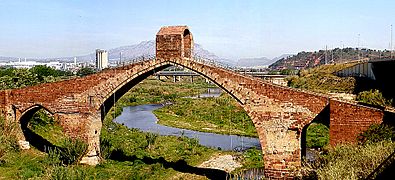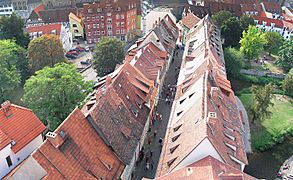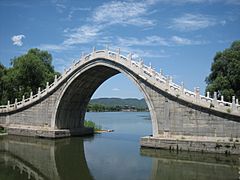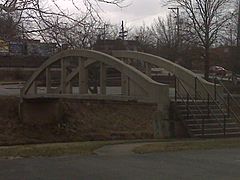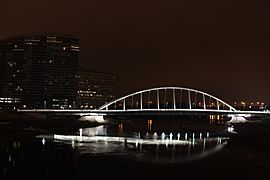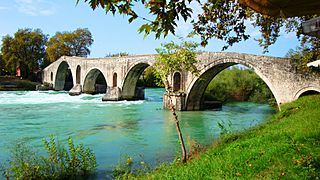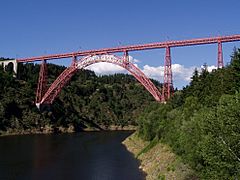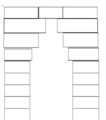Arch bridge facts for kids
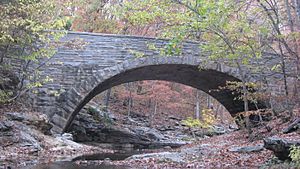
An arch bridge is a bridge with abutments at each end shaped as a curved arch. Arch bridges work by transferring the weight of the bridge and its loads partially into a horizontal thrust held by the abutments at either side. A viaduct (a long bridge) may be made from a series of arches. However other less expensive structures are typically used today.
Contents
History
The oldest existing arch bridge may be the Mycenaean Arkadiko bridge in Greece. It was built in about 1300 BC. The stone corbel arch bridge is still used. The well-preserved Hellenistic Eleutherna Bridge has a triangular corbel arch. The 4th century BC Rhodes Footbridge rests on an early voussoir arch.
Both the Etruscans and ancient Greeks knew about arches. But the Romans were the first to use arches for bridge construction.
Roman arch bridges were usually semicircular. A number were also segmental arch bridges (such as Alconétar Bridge), a bridge which has a curved arch that is less than a semicircle. The advantages of the segmental arch bridge were that it allowed great amounts of flood water to pass under it. This would prevent the bridge from being swept away during floods. Also the bridge itself could be more lightweight. Generally, Roman bridges had wedge-shaped primary arch stones (called voussoirs) of the same in size and shape. The Romans built both single spans and lengthy multiple arch aqueducts. Their bridges featured flood openings in the piers.
In medieval Europe, bridge builders improved on the Roman structures by using narrower piers. They used thinner arch barrels and lower span-rise ratios on bridges. Gothic pointed arches were also introduced reducing lateral thrust. In particular the 14th century saw bridge construction reaching new heights. Spans of up to 40 metres (130 ft) were previously unheard of in masonry arch construction.
Simple compression arch bridges
Advantages of simple materials
Stone, brick and other similar materials are strong in compression. They are fairly strong in shear. But they cannot resist much force in tension. As a result, masonry arch bridges are designed to be constantly under compression. Each arch is constructed over a temporary falsework frame, known as a centring. In the first compression arch bridges, a keystone in the middle of the bridge bore the weight of the rest of the bridge. The more weight that was put onto the bridge, the stronger its structure became. Masonry arch bridges use fill material (typically compacted rubble) above the arch in order to increase this dead-weight on the bridge. This also prevents tension from occurring in the arch ring as loads move across the bridge. Unreinforced concrete was also used. When masonry (cut stone) is used, the angles of the faces are cut to minimize shear forces. Where random masonry (uncut and unprepared stones) is used they are mortared together. The mortar is allowed to set before the falsework is removed.
Construction sequence
- Where the arches are placed in a watercourse bed (on piers or banks) the water is diverted. This is so the gravel can first be excavated and replaced with a good footing (of strong material). From these, the foundation piers are erected or raised to the height of the intended base of the arches. This is a point known as the springing.
- Falsework centering (in British English: arch frame) is built, typically from lumber. Each arch of a multi-arch bridge will create a thrust upon the arches next to it. For that reason it is necessary either that all arches of the bridge be raised at the same time, or that very wide piers be used. The thrust from the end arches is taken into the earth by substantial (vertical) footings at the canyon walls.
- The several arches are (or single arch is) constructed over the centering. Once each basic arch barrel is constructed. The arches are (or arch is) stabilized with infilled masonry. These may be laid in horizontal running bond courses (layers). They may form two outer walls, known as the spandrels, which are then infilled with appropriate loose material and rubble.
- The road is paved and parapet walls direct traffic to the bridge.
Gallery
-
Fredrikstad bridge in Fredrikstad, Norway
-
Bridgeport Lamp Chimney Company Bowstring Concrete Arch Bridge located in Bridgeport, West Virginia
-
The Main Street Bridge in Columbus, OH is the only inclined-arch suspension bridge in North America.
-
Bridge of Arta in Arta, Greece
-
The Roman Alcántara Bridge, Spain (built 103-106 AD)
-
Segovia Aqueduct (c. 100 AD)
-
Devil's bridge, Céret, France (1341)
-
The Ponte Vecchio, Florence, Italy (1345)
-
Richmond Bridge, oldest operational bridge in Australia (1825)
-
Falsework centering in the center arch of Monroe Street Bridge, Spokane, Washington. 1911.
-
Cotter Bridge, a through arch bridge that has open spandrels
-
Corbel arch in the shape of an isosceles triangle, supporting the Greek Eleutherna Bridge
-
The three-story Roman Pont du Gard aqueduct
-
One arch bridge Stari most in Mostar Bosnia and Herzegovina
-
Rialto Bridge over the Grand Canal in Venice, Italy (2011)
-
The Main Street Bridge in Columbus, OH is the only inclined-arch suspension bridge in North America.
-
The dry stone bridge, so called Porta Rosa (4th century BC), in Elea, Province of Salerno, Campania, Italy (2005)
-
Pont du Garde, a Roman aqueduct in Vers-Pont-du-Gard, Gard, France (2014)
-
Union Arch Bridge carrying the Washington Aqueduct and MacArthur Boulevard (formerly named Conduit Road), Cabin John, Montgomery County, Maryland, U.S.A. (2008)
-
Arlington Memorial Bridge over the Potomac River in Washington, D.C., U.S.A. (2007)
-
Key Bridge over the Potomac River in Washington, D.C., U.S.A. (2006)
-
Woodrow Wilson Bridge carrying Interstate 95 (I-95) and the Capital Beltway over the Potomac River between Alexandria, Virginia and Oxon Hill, Maryland, U.S.A. (2007)
-
Tyne Bridge over the River Tyne, Newcastle upon Tyne, England, U.K. (2004)
-
Hell Gate Bridge over the East River, New York City, New York, U.S.A.
-
Sydney Harbour Bridge, Sydney, New South Wales, Australia (2010)
-
Gateshead Millennium Bridge over the River Tyne, Newcastle upon Tyne, England, U.K. (2005)
-
Bridge over the Autostrade A1 motorway in Reggio Emilia, Italy (2015)
Images for kids
-
Richmond Bridge, oldest operational bridge in Australia (1825)
-
The three-story Roman Pont du Gard aqueduct
See also
 In Spanish: Puente en arco para niños
In Spanish: Puente en arco para niños


